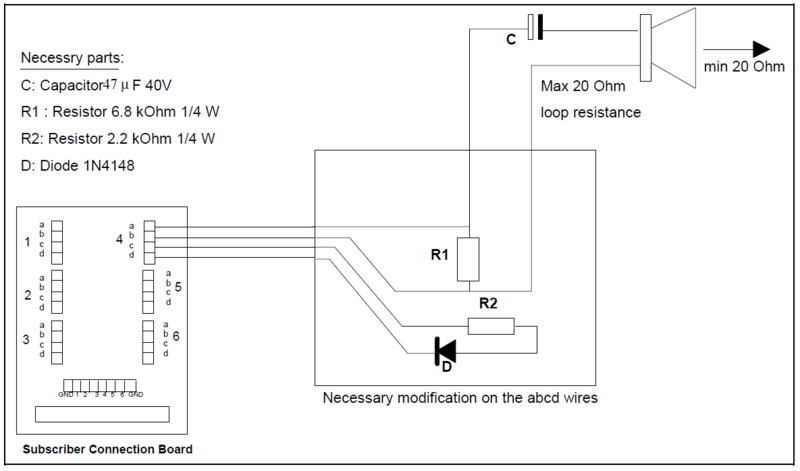ASLT and Connection of Loudspeaker
From Zenitel Wiki
It is possible to connect a loudspeaker directly on a subscriber output. See the drawing below. Note the modifications on the audio wires.
Only the capacitor is needed if loudspeaker is connected in parallell with a station.
Contents
General Considerations
If you have an installation with mostly 20 ohm loudspeakers, you need to consider the following factors concerning power supply and temperature.
ASLT2 (Produced from August 2000)
Maximum power output per subscriber is:
- 0.6W in 20 ohm (3-4W on ASLT)
- 1.6W in 40 ohm (similar to ASLT)
- 1.0W in 60 ohm (identical to ASLT)
- Max two 20-ohm loudspeakers per ASLT2 when used for alarm signaling (GA)
- Max three 20-ohm loudspeakers per ASLT2 when used for speech (PA)
ASLT (Produced until 2000)
On average, one 20 ohm loudspeaker with a maximum output signal can be connected for each 4 subscribers. If the maximum load is used only for a short period, this limit can be extended. Physical connections for subscribers with a load of 20 ohm should not be next to each other on the subscriber board. This is to avoid “hot spots”. They should be distributed as follows:
- 1st board: 2 subscribers
- 2nd board: 1 subscriber
- 3rd board: 2 subscribers
- 4th board: 1 subscriber
- etc.
Power Supply
There will always be a certain amount of loop resistance in an installation. A 150 m cable run of 0.6 mm2 cable gives a loop resistance of 20 ohm. It is also not likely that all connections are set to give the maximum volume. In a normal installation, output per station is about 2 W. In such an installation, you should add a second power supply for more than 40 subscribers, and a third one for more than 80.
Temperature
With an efficiency of about 50% for the amplifier, the other half of the available power is transformed into heat. With 100 subscribers in an All Call, this means 600 W, taking into account the minimum idle current and the efficiency of the power supply. It is also extremely important that the ambient temperature is not much more than 20 o C. It is also essential to ensure adequate ventilation, especially when building the AlphaCom into a rack.
Input Level for Alarms
Keep in mind that continuous sine tones have a very high intensity (100% of the total signal) compared with music (30%) and speech (10%). This means that in a sustained alarm situation where continuous sine tones are used, it is important that the input level does not get too high.
Subscribers per Power supply
Increasing the number above the specifications below will result in a temperature rise, which causes more stress on components and reduces the system lifetime. If you exceed these limits, add one or two extra power supplies as needed.
Technical Comments
60 Ohms
The AlphaCom has been tested with standard cabinet, 138 stations with 60 ohm speakers close to the exchange, 2 power supplies, and sine alarm tone on all stations. This setup can run for hours without problems. It becomes very hot, so 3 power supplies are recommended in such an installation.
20 Ohms and Long Cables
When you use 20 ohm speakers, with theoretical 4 W output, power consumption and ASLT, overheating becomes a problem. In installations with cable lengths of 100-500 meters, the cable resistance quickly reaches the speaker resistance level, even with 0.8-1.0 mm2 wire. A load of 40 ohm (1.5 W) is no problem for the AlphaCom. In addition, human speech is a much lighter load than a continuous tone, and an All Call usually lasts less than a minute, often just seconds. The power supplies can provide currents that are 50% above the nominal rating for this period. Recommendations for high-power systems:
- Use 3 power supplies
(Calculations: ASLT amplifier has 50% efficiency, the power supply 70%. To determine when 3 power supplies are required, the actual installation cables must be known, and what type of signal will be used - tone 100%, music 30%, speech 10% of full power).
- Have a good rack with sufficient ventilation, and keep the environment temperature at the recommended 20 degrees C.
- Use local amplifiers, e.g. a 6141 20 W/4 ohm unit with local power.
20 Ohms and Short Cables
A full module will not operate forever with a sine alarm tone using this load. What happens is:
- As the temperature inside the module rises, the on-board temperature sensors will turn the ventilation module fans on to their maximum speed.
- After some time, the power amplifiers on the ASLT boards will reach a built-in temperature limit, and each amplifier will shut down. The amplifiers will switch themselves on again when they have cooled down sufficiently.
- The power supplies will also reach a temperature limit where they shut down automatically. When cooled sufficiently, the power supplies will resume operation again.
We cannot predict whether it will be the amplifiers or the power supplies that switch off first (or a mixture). To sum up: No part of the exchange will be harmed by an overload, but there is no "graceful degradation".

